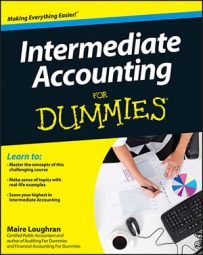Three types of businesses operate: service, manufacturing, and merchandising. Breathe a sigh of relief, because you have to worry about only two (manufacturing and merchandising) here. Service businesses don’t provide a tangible good and normally don’t have any type of appreciable inventory.
Service companies provide more of a knowledge-based work service — think dentists, family physicians, or accountants. However, if a service company keeps a large amount of office supplies or other products on hand, they may take it to the balance sheet as inventory instead of immediately expensing the purchase.
Manufacturing companies make products that merchandising companies sell. For example, Hewlett-Packard is a manufacturer of many different products, including printers; any retail outlet that sells those items is the merchandising company.
Merchandisers can be retail and wholesale. Wholesalers act as the middleman between the manufacturing company and the retailer. The retailer sells to the end-user customer.
In a nutshell, that’s the difference among service, manufacturing, and merchandising type businesses — pretty straightforward. The next section looks at special types of inventoried goods, including goods in transit, consigned goods, and special sales agreements.
Who owns goods in transit?
Inventory in transit is a big issue for both revenue and inventory valuation. Who owns goods that are neither here nor there? It’s a hot button as well if the company is undergoing a financial statement audit, when certified public accountants check to see if reports prepared by managers of companies fairly present the company’s financial position.
Two key terms spell out who owns goods in transit: FOB shipping point and FOB destination. FOB stands for either free on board or freight on board. FOB shipping point means that the sale to the customer occurs at the shipping point, or when the goods leave the seller’s loading dock. FOB destination indicates that the sale occurs only when the goods arrive at their destination, the buyer’s receiving dock.
Goods shipped to a destination point are included in the seller’s inventory until the buyer receives and accepts the goods. So the value of the inventory remains as a current asset; it doesn’t migrate to the income statement as a cost of goods sold and revenue.
Consigned goods
Consigned goods are goods that a company offers for sale but that it doesn’t officially own. The company offering the goods for sale (the consignee) is acting as a middleman between the owner of the goods (the consignor) and the customer. The consignee is charged with safeguarding the consigned goods within its control, but legal title of the goods remains with the consignor.
In accounting for this type of extravaganza, make sure you include in your inventory any inventory for which your company is a consignor. Under no circumstances should the consignee include consigned goods as part of its inventory!
Special sales agreements
Inventory can be subject to sales transactions a bit outside the norm of a customer walking up to a cash register in a department store and exchanging cash for store merchandise. Three such sales transactions are sales with buyback agreements, sales with a high rate of return, and sales on installment.
Here is a thumbnail sketch of each:
Sales with buyback: The seller agrees to “buy back” the merchandise from the customer sometime in the future.
Sales with a high rate of return: Customers are afforded a liberal return policy for a full or partial refund.
Sales on installment: Purchases are made but not fully paid for at point of sale or delivery. Instead, they are paid for over time, in installments.
You may be wondering how to handle drop-shipping, or when a business sells a product shipped directly from the manufacturer. In most cases, the business taking the customer’s order doesn’t own the merchandise and thus can’t record it as inventory.

